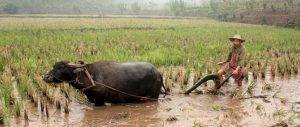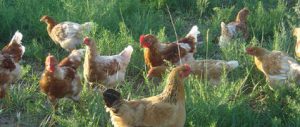China’s recent economic growth has been extraordinary but uneven. Vulnerable groups, such as smallholder farmers, are most affected by this unbalanced development, which has created enormous challenges: enduring extreme rural poverty and rising socioeconomic inequality, feminisation and ageing of the agricultural workforce, severe environmental degradation and erosion of biodiversity.
Food insecurity has been added to these concerns. It persists in a number of provinces, mostly in western and central China: 130 million people are believed to be food insecure or undernourished. Most of these people live in the mountainous regions of the north-west and south-west, which are characterised by fragile ecological conditions and underdeveloped infrastructure and services.
Since initiating reforms in 1978, China has won applause for its achievements reducing extreme poverty. However, severe poverty remains high in absolute numbers. Small farmers in the remote upland areas of south-west and north-west China, with an average of less than 0.2 hectares of land, are among the poorest of the poor. They are also the most affected by food insecurity. Although they hold land-use rights, in most cases the land is of such low quality it is not possible to achieve subsistence levels of production. Many poor farmers have to purchase additional food, and have been hit hard by increased food prices since the reforms.
Another major consequence of China’s reforms has been an overall increase in migrants moving from rural to urban areas, most of them men. Women now constitute 70% to 80% of the agricultural labour force in most rural provinces. But women’s increasing role in rural life is seldom noted by the key decision makers. The result has been an agricultural policy that often fails to address the needs of farmers in some of the most deprived areas.
Conventional crop research in China is well organised and has produced very good results, But it has been carried out mainly under favourable growing conditions, following a development path of high-input and commercialised agriculture. The past 15 years have seen spectacular results in China’s agricultural heartland thanks to the use of improved crop varieties and agricultural inputs – such as inorganic fertilisers, machinery and tools – supported by lower agricultural taxes, subsidies, price supports and market and infrastructure development. But less arable regions, including the mountainous areas of Guangxi, Yunnan and Guizhou in the south-west, have not been served well.
This is partly because of the prevailing assumptions of plant breeders, in turn supported by decision makers in agricultural development circles, that farmers are less knowledgeable than breeders, that selection must be done under optimum conditions, that cultivars must be genetically uniform and adaptable over large geographic areas and that local, natural plant species must be replaced by high-yielding varieties under all circumstances to ensure national food security.
Privatisation of seed production has led to a focus on hybrids and other modern varieties, with almost total neglect of traditional varieties. Unfortunately, most hybrid varieties cannot adapt to the conditions in remote mountainous areas, including to increasingly variable weather conditions. They are also susceptible to disease and pests. Farmers in these regions have not been able to adopt hybrids and continue to rely on local varieties.
To address the multiple challenges affecting rural China, in 1999 a novel initiative was started by several groups of women farmers, a number of rural villages, two plant-breeding organisations and the Center for Chinese Agricultural Policy (CCAP), the country’s leading public agricultural policy research organisation. Research began in Guangxi Province, located in the south-west and a risk-prone area.
CCAP’s senior researcher Yiching Song developed the initiative, launching an ambitious agenda including crop rotation and organic fertilisers. At the heart of the efforts is an approach known as participatory plant breeding, in which professional breeders and farmers join forces to improve crops, blending scientific and traditional knowledge.
The work of the research team, including the farmers, built on local maize-breeding experience. At the same time, the team sought the expertise of formally trained plant breeders. Crop improvements were made through a number of crossing techniques and variety selection processes, which involved detasseling, mass selection and line selection by farmers with support from breeders. Breeders went on to use more complex methods in the fields of the Guangxi Maize Research Institute (GMRI) in Nanning.
So far, these trials have led to higher-yielding varieties that are at the same time more resilient to stresses like pests, disease and drought. More than 80 varieties have been used in the trials. Based on 10 years of experimentation, five farmer-preferred varieties have been selected and released in the research villages. They have also spread beyond these villages. In 2008, similar work started in the neighbouring provinces of Yunnan and Guizhou.
This sort of collaboration between farmers and plant breeders is still new and requires time and effort by all parties to entrench the practice. It represents novel policymaking and is being followed with interest by both the Ministry of Agriculture and the Ministry of Environmental Protection.
The initiative is also exploring new efforts to market local crops. Two organic or green farming associations, established by local farmers but supported by the research team, are becoming increasingly well-known in Hengxian County in south-east Guangxi.
The first organic products from Guangxi, rice and kohlrabi, have found markets in Nanning, Liuzhou and even as far away as Hong Kong. In the city of Nanning, a new organic-food restaurant – the first of its kind in the provincial capital – purchases produce directly from the two organic associations and is quickly gaining popularity.
The two organic associations, based in the villages of Chentang and Sancha, were established in 2005, a year after the conversion to organic methods was initiated in a move away from increasingly costly and risky industrialised forms of farming. Farmers began to reorganise their work through more cooperation, relying on local resources (such as organic fertilisers and natural pesticides) and a collective spirit of crop management and experimentation.
Starting with only 10 farmers, they were soon able to obtain technical guidance and some financial support from Partners for Community Development (PCD), a Hong Kong–based NGO supporting poverty alleviation and grassroots development. In 2006, PCD staff began working with team members from CCAP and GMRI to improve local crop varieties. They received technical training and also support to improve the organisational processes, from production to marketing.
The organic associations organise regular communications among their members to improve farming skills and give them a deeper understanding of the advantages of organic farming. The members are divided into small groups to monitor each other’s planting efforts and make sure that everyone avoids the use of chemical fertilisers and pesticides.
The growth of the organic associations has not been without challenges. The leaders have invested a lot of time and energy, and also their own money, in organising activities and exploring the market, without receiving any payment. Their voluntary efforts are not sustainable in the long run. Additionally, as more members join, the associations struggle with adequate and timely provision of training in the basic techniques and skills of organic farming. How to professionalise the associations is becoming an issue.
What lies ahead?
Farming in south-west China is experiencing a transformation, in certain areas resulting in crises. ![]() In marginalised areas, such as in the mountains of Guangxi, farmers’ seed-conservation methods continue to play a major role in meeting their various needs. These systems face challenges, such as genetic erosion, but still maintain the biodiversity that is necessary to sustain agriculture. Current and future plant-breeding efforts – in the face of climate change and other impacts, such as natural disasters – will depend on these systems.
In marginalised areas, such as in the mountains of Guangxi, farmers’ seed-conservation methods continue to play a major role in meeting their various needs. These systems face challenges, such as genetic erosion, but still maintain the biodiversity that is necessary to sustain agriculture. Current and future plant-breeding efforts – in the face of climate change and other impacts, such as natural disasters – will depend on these systems.
Organised women farmers in particular have taken the initiative to become qualified seed producers and distributors. New organisational forms are emerging to support these efforts, and changes are already occurring in relevant policy domains. Lack of useful information about new technology and markets is one of the key constraints on agricultural production. Organised farmers have established new links with extension services to solve the problems they face in these arenas.
“Our work in Guangxi tells us that we need to work together with scientists from many disciplines, and with multiple stakeholders from multiple levels,” concluded Yiching Song in an interview late last year. “Field-level action can bring about change by forging social ties with others interested in promoting fair and equitable rural innovation and livelihoods.
“It also shows that concrete action can bring about more profound innovation through better understanding of and dealing with the complexity of rural realities, step by step. It takes a long time, but it is possible.”
Ronnie Vernooy is a rural development sociologist with a particular interest in agricultural biodiversity and natural resource management. His email address is [email protected].
This article first appeared in Solutions journal. It is edited and reproduced here with permission.
This article is published as part of our Green Growth project, a collaboration between chinadialogue and The Energy Foundation.
Homepage image by mksfca





